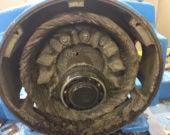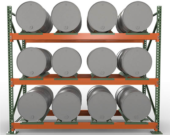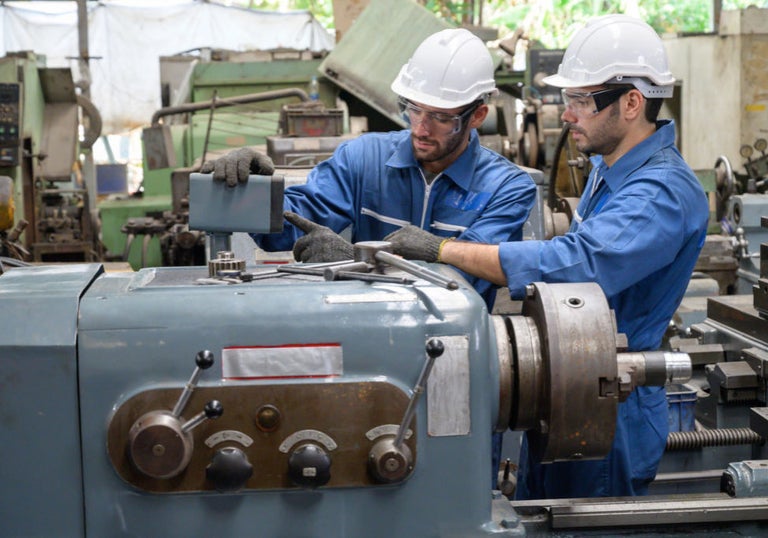In our last blog post, The 4 Types Of Lubricants for Industrial Machines, we talked about when to use these 4 types of lubricants: Oil, Grease, Dry Lubricants, and Penetrating Lubricants.

The Dangers of Overgreasing
We know the phrase “the more the merrier” can be applied in most situations, but definitely not when it comes to greasing your machine. Overgreasing the bearing cavity can be a costly mistake and will create the following chain reaction:
- The rotating bearing elements will begin churning the grease, in doing so, grease is pushed out of the way. This will result in energy loss and rising temperatures.
- Rapid oxidation of the grease occurs, also known as chemical degradation
- A reaction occurs between the oil and thickener, causing them to separate and generate heat from the oil bleed.
- The heat cooks the grease thickener into a hard build-up and blocks new grease from reaching the core of the bearing.
Ultimately, this chain reaction will accelerate any wear of the rolling elements and component failure.

Undergreasing
Undergreasing is just as problematic for the overall health of a machine as overgreasing. By now you’ve seen or heard of the term grease cakes. This is where the grease separates leaving behind solvents. Caking grease causes a loss of lubricity which inevitably leads to metal-to-metal contact and bearing failure.

Properly Greasing a Bearing
There is no one size fits all solution for greasing a bearing, as the dimensions of the bearing or the housing are what ultimately determine how much grease is required. When greasing a bearing, it is important to select the proper lubricant based on the specific requirements of the application. To do this, consider parameters such as the speed, type, and size of the bearing. Also, take into consideration it’s operational temperature and any nearby parts of the machine. Use this insight to select a lubricant that will allow the bearing and machine to operate at its most efficient state.
For example, when working with a bearing cavity, carefully hand pack the bearings, and pump a measured amount into the cavity according to the application and manufacturer specification. Bearings in a remote location often require an auto lubricator that will dispense small measured amounts of lubricant at frequent intervals while your machine operates. This sounds like a dream, but it comes with a catch; you will have to check the lines often for solvent and grease separation.

Cleanliness
Lubrication cleanliness is something that’s not often taught, and is absolutely necessary. Cleanliness is a state of mind. If you ask your kid to clean their room, usually their version of “clean” isn’t the same as yours. Unfortunately, unlike your child’s bedroom, cleanliness with lubrication is an impending disaster. If machines are not properly maintained to the degree that they aren’t kept clean, they will eventually evolve into a state of disrepair. So how do you practice cleanliness when working with lubrication?
- Filter oil.
When you purchase new lubricating oils, you are paying for a product that you shouldn’t put to immediate use. Oil should be filtered and pumped immediately into a clean contaminant-free barrel to ensure it isn’t exposed to the air and microscopic particles. - Use high-quality top-up containers.
Make sure they are clean and sealable to keep out contaminants. Clearly mark the container to avoid grease compatibility issues. - Avoid using funnels. Since funnels are often collecting dust on a dirty shelf, it’s likely that they will contaminate your lubricant.
- Monitor lubricant shelf life.
Shelf lives are based on the lubricant additives, which will affect performance in as little as six months in storage. The supplier or manufacturer will often assign the shelf life. Follow their recommendations to maximize the lifespan of your lubricants. - Use color-coded and clearly labeled lubricant identification tags.
Avoid grease compatibility issues, which could lead to unplanned downtime and costly repairs. Having a proper identification system helps solve this problem. We recommend using colors and shapes. Put a red triangle on one container, blue squares, etc… - Properly store lubricants.
At Acoem we have a saying about storing lubricants, “Cool, clean, and dry.” Keep your lubricants in a temperature-controlled environment (cool), keep them away from contaminates (clean), and keep them away from any moisture (dry).
Purging
When adding new grease to a grease gun it’s always a good idea to purge it to avoid any issues with compatibility. Simply squeeze the trigger a few times until you have very little to no grease left. Then load with new fresh grease.
Over time, oil can separate from grease if it sits in the grease line or hose for too long. Because of this, it’s imperative to monitor and purge the grease line when necessary. If grease is separating and you use that among your machines, you’re just waiting for a critical disaster to happen.
We hope this helps you understand more about how to properly lubricate your machines and how to keep them running smoothly. Check out our video below on Lubrication that covers some of the information on performing machine lubrication.








